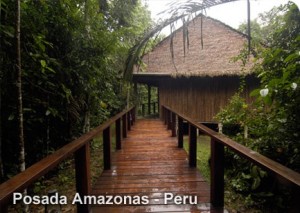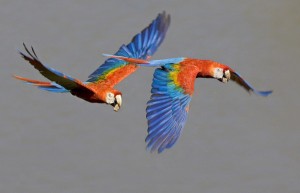Rainforest Expeditions - Nature is our passion
“Nature is our passion, sharing it is our commitment. We build sanctuaries that host unique experiences, engage local communities, and help hosts and guests learn to value their relation with the Earth.”
|
 © Mike Ritter This, quite simply, encapsulates the reason for the existence of Rainforest Expeditions - an organisation which operates three award-winning lodges in Peru. At Posada Amazonas, Refugio Amazonas and Tambopata Research Centre, Rainforest Expeditions has created for its visitors true ecotourism experiences such as birdwatching, sustainability, research and wildlife observation, in the middle of the jungle, in the heart of the Amazon rainforest. Founded in 1989 by Kurt Holle and Eudardo Nycander, Rainforest Expeditions aims to become, in Kurt Holle’s words, “a major force in the conservation of this corner of the world, by using tourism and related market forces to create incentives for conservation”. The three lodges, with a total occupancy of 80 rooms, are a nature lover’s dream - simple, charming, comfortable - and as close to nature as one could wish to be, with the sights and sounds of the Amazon not much more than an arm’s length away. Situated beside the world’s largest Macaw Claylick, on the uninhabited frontier of the Tambopata National Reserve and the Bahuaja-Sonene National Park, the Tambopata Research Centre was the first of the three lodges to be established - in 1989 . The aim of the project was to protect the macaw and ensure the survival of its populations, and with the incorporation of Dr Donald Brightsmith in 1998, Tambopata has become one of the world’s foremost studies on wild macaws. Posada Amazonas is located in the private reserve of the Ese-Eja community of Infierno, which itself is directly adjacent to the Tambopata National Reserve. Because of its accessibility, the excellent opportunities to observe wildlife and its cultural context, it’s a perfect introduction to Amazonia’s richest rain forests and jungle, and popular for short stays. The latest addition to the Rainforest Expeditions portfolio is Refugio Amazonas, immediately adjacent to the Tambopata National Reserve. Located about two hours upriver from Posada Amazonas, Refugio Amazonas is surrounded by waterways and habitats, offering wonderful opportunities for exploration of the natural world. It’s well placed for either standalone short experiences, or for breaking an expedition to or from Tambopata Research Centre. It operates in collaboration with environmental education NGO, ANIA, and caters for families with children of all ages. click to enlarge The Tambopata River and clay lick at Tambopata Research Centre Photo © Mark Stafford “The locations of the projects,” says Kurt Holle, “were selected because of accessibility, the great forests which surround them, and their wildlife resources. Ecotourism is growing significantly in popularity, and travel to our protected areas has grown more than ten times in the past fifteen years. The trend is very similar for protected areas with tourism potential everywhere. “There are a number of drivers behind the growth of ecotoursim,” explains Kurt. “The increasing need for people to get away from cities, the increasing interest for people to grow intellectually in their vacation, growth of the ‘green conscience’, the popularity of nature shows on TV channels like Discovery, National Geographic or Animal Planet - and also the less exotic nature of the exotic! As people travel more for business or pleasure, exotic countries have become more familiar.” Kurt’s explanation of how he came to establish Rainforest Expeditions is brief. “I was a rainforest fanatic from childhood, and having studied forestry, took a wrong turn and wound up in tourism!” His interest in the natural world was obviously the lodestar for his significant achievement in promoting ecotourism - and environmental welfare was clearly on the winning side. Rainforest Expeditions collaborates with a number of high profile partners on ecological programs and research initiatives. The American Bird Conservancy, for example, financed research on the harpy eagle, and Rainforest Expeditions currently hosts six to eight Earthwatch groups a year - they work on the macaw project, part of which is funded by Earthwatch participants. Four Stanford University interns are also hosted every year, conducting research on topics related to biology and the use of resources. “The Giant River Otter program,” says Kurt, “operates in partnership with the Frankfurt Zoological Society. We collect data that we pass on for analysis, and they visit the lakes we work in a couple of times a year. The combination of both gives us an indication of the behavioral ‘health’ of the families of otters we work with.” Another example is the radio collar monitoring programme. “WWF has put transmitters on macaws and jaguars,” he explains. “These collect GPS information over a period of time. If two transmitters come close, then they exchange information, and once or twice a year researchers collect the data by flying over, or such. The object is to find how large the ranges of these species are, to properly argue for the establishment of protected areas of the relevant size needed.” Environmental welfare is by no means the only beneficiary of the influence of Rainforest Expeditions. In order to commit communities to conservation, RFE channels the economic incentives from tourism to local communities, establishing concrete links between standing primary forests and healthy wildlife populations and local families. “Our work with communities, flagshipped by Infierno, has three areas where there are positive Blue and Gold Macaws above the clay lick Blue and Gold Macaws above the clay lick Photo © M Stafford “Socially, I would say the principal impact is that the community as an organization has more tools or more choices in their list of how to confront any given challenge. And environmentally, on the one hand you have a community that is adamant in the protection of the 4000 or so hectares it uses for tourism, but on the other hand, much of the increase in income has been used to purchase chainsaws or reinvested in farms.” Rainforest Expeditions has no immediate plans to extend beyond the borders of Peru - “We don’t rule it out, but it’s not in our current plans.” More lodges within Peru might possibly be established, as long they fall into what Kurt describes as “the neighbourhood of our current area of work”. As far as challenges in the future are concerned, the Interoceanic Highway - to link the Amazon basin with the Pacific coast of Peru - is nearing completion. “The Interoceanic Highway,” says Kurt, “is the single biggest challenge we will be facing, as it will bring (and already is bringing) large numbers of settlers into the region who will dedicate themselves to illegal gold mining or squatting and converting forest to farmland. It could also bring pressure for conversion of forest to industrial soybean or palm-oil agriculture.” It is sincerely to be hoped that this development will not impact on the tremendous value which Rainforest Expeditions has brought to this pristine corner of Peru. Visit Rainforest Expeditions website at: www.perunature.com |



















